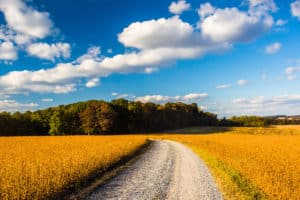Donald Trump’s 2016 presidential campaign has been like nothing we ever have seen in modern politics. Trump has introduced many new topics into a presidential race, including energy levels, height, Fifth Avenue shoot-outs, vulgarity, and twitter fights. Among these new topics are conservation easements, a niche real estate and tax device about which most Americans are not aware. Among their many features, conservation easements allow for potentially significant tax deductions related to golf courses under the U.S. Tax Code, and Trump has used those to great advantage.
Trump has not released his recent federal tax returns, which is an anomaly among presidential candidates. However, investigators searching for information about his tax history determined that Trump has availed himself of conservation easement tax deductions for several of his golf courses and other properties.
Conservation easements are voluntary legal agreements between property owners and a qualified government agency or nonprofit organization to promote open space, historic preservation or protection of natural resources. They are provided by statute. The owner agrees to restrict the type of activity on the property, particularly in relation to development. The agreement is perpetual in duration, so it binds future owners of the property as well. Conservation easements have helped to protect millions of acres from development.
Under Section 170 of the Internal Revenue Code, the property owner can receive a tax deduction for entering into a conservation easement, if the property satisfies certain conditions. To qualify for a charitable deduction, the conservation easement has to satisfy three requirements: (1) the easement’s duration must be perpetual, (2) the easement must be granted to a qualified organization, and (3) the easement must satisfy a conservation purpose. Each of these terms is defined in the Internal Revenue Code, and easements and their tax implications can be extraordinarily complex. If the tax code requirements are satisfied, the property owner may deduct from its taxes an amount equal to the difference between fair market value of the property before granting the easement and fair market value after the grant. Other additional tax benefits can be available at the state and local levels. According to the IRS, 1,114 taxpayers donated a total of $972 million in conservation easements in 2012.
Donald Trump availed himself of the benefit of conservation easements in a way that was neither illegal nor much different than many other land owners in the United States. In his usual fashion, however, Trump’s use of conservation easements are done in a very big and very noticeable way. The sheer size of Trump’s tax deductions has caused many, including the IRS, to question whether conservation easements on golf courses reflect the public policy behind the provision in the Internal Revenue Code.
Trump has placed conservation easements on several of his properties. He placed an easement on 74 percent of his estate in Westchester County, New York. In 2014, Trump entered into an easement that prohibited construction of houses on Trump National Golf Club’s driving range in Los Angeles. In 1995, he put an easement on his Mar-a-Lago Club in Palm Beach, Florida that protected the historic features of the building. Trump later expanded the easement to limit home development on the property. Donald Trump was allowed a $39.1 million deduction from his 2005 federal income taxes as a result of an easement on Trump National Golf Club in Bedminster, New Jersey. Of the $1.8 billion in conservation easement deduction in the U.S. in 2005, the $39.1 million deduction that Trump took represents roughly 2% of that amount.
Golf courses are especially contentious for conservation easements because in some cases it appears that the conservation spirit of the public policy is being exploited. The people against golf courses receiving easements argue that highly-developed courses, with fertilizers and chemicals, do not serve any conservation purpose. Whether or not a highly-maintained 18-hole golf course can satisfy a conservation purpose and receive a tax break has been subject to several disputes in court. Since 2004, the IRS has increased scrutiny regarding conservation easements on golf courses.
In one case, commonly known as Kiva Dunes, the property owner placed a conservation easement on an Alabama golf course and claimed a tax deduction of $30,588,235. The IRS contested the deduction, and the property owner filed a lawsuit in U.S. Tax Court. There were several key points in Kiva Dunes, but the case is significant because the IRS recognized that conservation easements on golf courses may satisfy conservation purposes. The property ultimately received a tax deduction of $28,656,004.
A second matter involved golf courses at St. James Plantation in North Carolina. The property owner claimed roughly $8 million as a tax deduction for a conservation easement, which the IRS disputed. This case also went to the U.S. Tax Court. The property owner in this case lost in tax court. The conservation easement included all parts of the golf course, including the greens, tees, and paved cart paths. The court ruled that this easement did not satisfy the conservation purposes of the statute.
The National Golf Club of Kansas City and the Champions Retreat Golf Club in Evans, Georgia also have disputes being resolved in tax court revolving around similar issues.
The Obama administration has had issues with conservation easements as well. It took aim at the apparent excesses of conservation easement charitable deductions related to golf courses and removed golf courses from charitable deduction candidates in its fiscal 2013 revenue proposal. The golf courses ultimately remained as candidates for charitable deductions, but Obama’s removal of golf courses from the list of potential conservation easement deductions may have been in direct response to the Kiva Dunes result.
Conservation easements have been a complicated and contested area of the Internal Revenue Code almost since their creation. As conservation easements have become increasingly more popular both as land planning and tax planning devices, the controversy only has increased. Many people in the United States use conservation easements as a legitimate means to preserve pristine land. However, as golf course investors continue to see conservation easements as a business revenue device, rather than a conservation tool, we will continue to see these disputes land in the U.S. Tax Court.
As for Trump, whether he is a true conservationist or just one to exploit the tax code for the financial benefit of his golf courses is a point that people can continue to argue, along with all the other new and novel issues he has brought to the 2016 campaign.
This content may not be used or reproduced in any manner whatsoever, in part or in whole, without written permission of LANDTHINK. Use of this content without permission is a violation of federal copyright law. The articles, posts, comments, opinions and information provided by LANDTHINK are for informational and research purposes only and DOES NOT substitute or coincide with the advice of an attorney, accountant, real estate broker or any other licensed real estate professional. LANDTHINK strongly advises visitors and readers to seek their own professional guidance and advice related to buying, investing in or selling real estate.










While I wrote the message below as a first thought to this issue, I am rethinking some of it now… Since a conservation easement can (not always) financially devalue property, it may not be a bad thing to grant them to golf courses. Sub/urban open space has a great social value. The reduced financial value of a golf course with a C.E. opens the possibility to a future use of the land other than golf. Thus the easement provides flexibility for other beneficial uses at below market value.
To illustrate there is a company that builds swimming pools on the order of 5 or 10 acres that is indicating a number of golf resorts are turning to other recreation in a resort market oversaturated with golf. These resorts are supposedly enjoying success with other recreation including the oversized pools due to a broader popularity for full family recreation. In the future it is possible that these types of pools/waterparks with a beach could give way to very attractive actual habitats such as the valuable natural lakes and streams we build. Recreation in society is not forever static. Decades from now people like Donald Trump might actually be praised for his creative use of “conservation” easements as people enjoy acres of lush wildflower meadows, beaches, and pristine natural waters in the style of future user-friendly natural parks/areas. We enjoy the irony that Trump National Fish and WIldlife Preserve Park will have as some people grin at the name while others beat their heads with their birkinstocks. Perhaps not every golf course shoud qualify here, but there are more than a few that could turn out to be a great bet for conservation in the future. Something to think about.
***************************************************************
Original Message:
We have a simple illustration to differentiate a golf course from habitat:
For a garden hose of water you have a choice: 1) an acre of pond or lake if designed correctly is filled with native fish, amphibians and thousands of rare wildflowers, or 2) an acre of fairway that will feed geese and leach excessive nutrients into the surface aquifer. Goose hunters do not get a vote in this… Which of these two sounds more like habitat?
While golf courses can be attractive to the sub/urban eye, they don’t offer much for wildlife other than grass and a drink out of a water hazard. ( by the way, we are not “greenies”. We are hard corp Biologists who only follow real science)